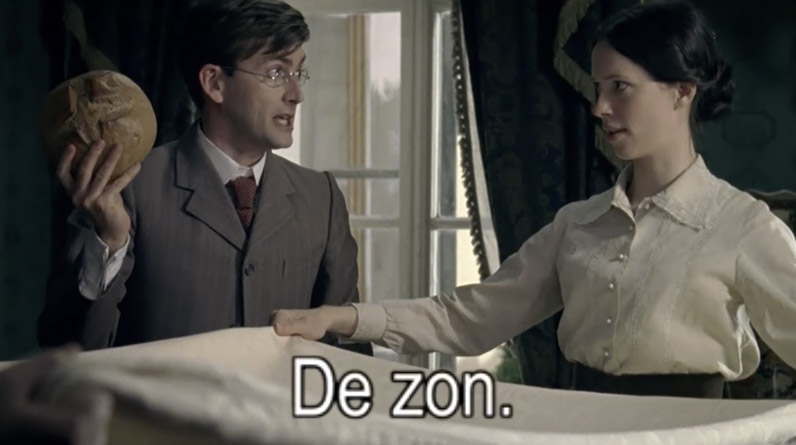Exploring gravity waves
The carnival mirror effect

How do you measure a gravitational wave?
An apparent rule in physics seems to be ‘the smaller the phenomenon, the larger the machine needed to measure it’. The European installation, Virgo, has two arms that measure three kilometres each. They have been set up in the shape of an L.
A laser beam runs through each arm of the Virgo, meeting at the corner of the L. They have been aligned in such a way that the lasers’ light waves cancel each other out. Physicists call this phenomenon interference. Under normal circumstances, the detector has no visible laser light running through it.
When a gravitational wave travels through an object, this object will briefly be compressed and expanded. Should a wave travel through the Virgo, one of its arms will briefly be longer than the other. This means the two lasers are briefly out of step, and cease to cancel each other out. This results in a short laser flash in the detector. The difference in length you can measure is 100,000 times smaller than a proton, one of the components that make up atoms.
Gravitational waves as explained by Bruno van Waayenburg from NRC.
Two years ago, you had probably never heard of them. But suddenly, they were everywhere. Every single news outlet was talking about the phenomenon whose existence Einstein had predicted a hundred years ago: gravitational waves.
This month, three scientists from the LIGO-Virgo consortium were awarded the 2017 Nobel Prize for Physics for their first discovery of a gravitational wave. New professor by special appointment Chris van den Broeck has been fascinated by the phenomenon for years. The astrophysicist has been working on gravitational waves for twelve years. He is connected to the LIGO-Virgo consortium via Nikhef, the Dutch physics institute. That means the RUG is getting a little bit of that Nobel Prize for Physics.
Van den Broeck is a big name for the RUG, but the man himself is exceedingly modest. ‘The Van Swinderen Institute is a group of people who are doing incredibly interesting things. I’m sure I’ll be able to learn a lot. I’m really happy to be a part of it’, he says, sipping his beer, a Palm – the astrophysicist is Flemish. Here in Groningen, he will mainly be teaching classes about gravitational waves and supervising PhD students.
Carnival mirror
So where do these illustrious gravitational waves come from? Van den Broeck lectures. ‘A piece of space debris will have gravity, but it doesn’t transmit gravitational waves. They aren’t created until an object moves’, he explains. The waves travel through the cosmos and distort the space they cross. They push and pull a little each way. Should a wave travel through you, you will be slightly wider in some places and a little thinner in others; you’ll look like you would in a carnival mirror.
Not that this would actually be visible. The gravitational waves are much too weak for this. ‘It sounds weird, since gravity is the force that keeps us tethered to earth. But gravity is actually the weakest of the four known forces of nature. Imagine you have some iron filings on a table. You can easily pick them up using a magnet, when the entire mass of the earth is pulling on them from below.’
We are probably being distorted by gravitational waves all the time, but most of them are so weak that we haven’t been able to measure them (yet). The waves that have been measured so far have been the result of unimaginably large masses out in the universe, such as black holes and neutron stars – collapsed stars of gigantic density.
Fire drill
Van den Broeck may speak in a soft voice, but his enthusiasm for his job is evident. ‘The Nobel Prize was cause for a party, but it paled in comparison to the discovery itself. That was amazing.’ On Monday, 14 December 2015, at the end of the morning, a signal came in. ‘We didn’t really believe it at first. The readings looked exactly like our simulations, it was almost too perfect.’ These simulations generate a fake signal by sending vibrations through the detector. ‘Only a few people in the consortium will actually know that it’s a simulation. The rest have to figure it out for themselves.’ Kind of like a fire drill.
‘We were hesitant at first, thinking that maybe it was another simulation.’ But later that night, around six o’clock, Van den Broeck had become convinced. For ten years, his work had been purely theoretical. It had only ever existed on paper, in his head, and in simulations. ‘Suddenly it’s like nature is talking to you. I had goosebumps.’
Scepticism
The men who took home the Nobel Prize this year had started the work that led to this particular breakthrough in the 1960s. ‘It’s been an extremely long road for them’, Van den Broeck says. For decades, they worked on something that ‘technically didn’t exist’. ‘Very few people actually believed it would be possible to measure these waves at all. They wondered if there weren’t better ways to spend the billions of funding, perhaps on something that actually had a chance of succeeding.’
But the pioneers prevailed and managed to convince the sceptics. Without their efforts, the extremely expensive equipment needed for this particular kind of research would never have been built. There are currently three detectors in the world that can measure gravitational waves. Two are in the US (the LIGOs), and one is in Italy (the Virgo).
The very first gravitational wave readings and the resulting media storm were an enormous boost to the research field. For a short while, Van den Broeck was famous. ‘I ran into a man walking his dog. I didn’t know him, but he recognised me. He wanted to ask me something about black holes.’ The field is also becoming more popular with students. ‘The number of students for my course in Amsterdam has doubled. Sure, only from ten to twenty, but still’, he chuckles.
Great impact
The gravitational waves have already had a great impact on science. The latest and so far strongest reading, which took place in the summer, on 17 August, yielded a wealth of information. One example: for decades, astronomers have been observing flashes of gamma radiation, a type of very strong light beams. They reasoned that they originated outside the Milky Way. But no one knew for sure how they were created. On 17 August, 1.7 seconds after a gravitational wave had been observed, satellites measured another one of those gamma flashes. But that’s not all. Twelve hours later, astronomers observed with their telescopes a flash of light. From the light frequency, they deduced that it came from two neutron stars colliding.
This not only allowed them to discern the source of the gamma radiation, physicists also concluded that gravitational waves travel at approximately the speed of light. ‘So now we have a new way of measuring distances in the universe: we can read a gravitational signal and know how far it travelled.’
Holy grail
Van den Broeck hopes to use gravitational wave readings and calculations to find out more about the mysteries that go on inside neutron stars. ‘We know very little about this. We lack the answers to the simplest of questions. Or worse, there are twenty different possible answers.’
The research into gravitational waves does have a holy grail, says Van den Broeck: ‘To measure the waves that were created during the Big Bang.’ The waves that were created then have been stretched out immensely due to the expansion of the universe. In order to measure that wavelength, you would need astronomically large equipment. Literally. The European Space Agency’s proposal to build a giant detector in space has already been approved. They want to launch three satellites in an orbit around the sun. Connecting them with lasers creates an extremely large version of the measuring equipment used on earth, with arms that are a million kilometres long.
In his function as professor by special appointment, Van den Broeck will focus on the so-called Einstein telescope, among other things. This is an underground detector that measures ten kilometres in length, which will potentially be built in the southern province of Limburg. ‘Underground, there are no external vibrations or noises’, Van den Broeck says. It would allow scientists in the future to measure more than 100,000 waves each year. And the RUG will be there.
Einstein’s space travel for dummies
If you go online to look for information on gravitational waves, you’ll likely find articles that explain them as ‘a ripple in space-time’. If that explanation makes you go ‘space-what now?’, you’re not the only one. ‘It’s tough stuff’, Van den Broeck admits. Time for a physics lesson. ‘Einstein came up with his theory of relativity in 1915. This theory replaces Newton’s theory of gravity.’ The latter is what students learn in high school.
‘In Newton’s theory, the earth rotates around the sun, because the sun exerts force upon the earth. Einstein came up with a different explanation. His theory of relativity says that the sun is causing space-time to curve.’ Imagine space-time as a stretched out rubber membrane. If you place a bowling ball in the middle of that membrane, it creates a curve. In this curve, earth is spinning like a ball on a roulette wheel.
But what does this have to do with gravitational waves? Van den Broeck: ‘Imagine if aliens showed up and started shaking the sun, just for fun. The ripples in the membrane would eventually reach the earth. These ripples are gravitational waves. Now, as far as we know, no aliens have been shaking the sun. So that means we need to look for other sources that created the gravitational waves.’ So far, the sources that have been measured are collisions between neutron stars and between black holes.’


